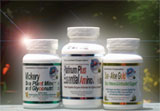Essential Fatty Acids
Dr. Brice E. Vickery
©11/26/2003–2007 SuperNutrient Corporation
The Story of Essential Fatty Acids
Symptoms of essential fatty acid (EFA) deficiency include hair loss, edema, kidney malfunction, dermatitis, hypertension, numbness of the extremities, joint swelling, gastrointestinal distress and immune malfunction. Since this information has become well known, grocery and health food stores sell large quantities of EFAs such as flax oil and fish oil. However, unless you know the full story behind EFAs, chances are you will remain EFA deficient, even though you are eating them.
WHAT ARE ESSENTIAL FATTY ACIDS (EFA)?
Essential fatty acids are polyunsaturated and super unsaturated acids, which our bodies need but cannot make and so must acquire in the diet. They are considered macronutrients because they are required in significant quantities daily. The two kinds of EFAs are linoleic acid (Omega6) and alpha linoleic acid (Omega3.) Some common sources of Omega 6s are safflower, sunflower, flax, borage and sesame oils. Some common sources of omega 3s are flax and fish oils. These are all readily available in stores, the problem is that most are refined, deodorized, rancid or toxic, rendering them useless to the body.
WHAT DO ESSENTIAL FATTY ACIDS (EFA) DO IN THE BODY?
They make prostaglandins series 1(PGE1) 2(PGE2) and 3 (PGE3). These hormone–like chemicals have a high turnover rate and play a large part in managing the daily housekeeping of cells. PGE series 1, 2, and 3 are all needed by the body in the proper balance. PGE1 keeps the blood mobile, helps remove excess sodium and fluid from the body, relaxes blood vessels, decreases inflammatory symptoms, regulates calcium functions, and supports the immune and nervous systems. PGE2 constricts blood vessels, promotes inflammation, fluid retention, and sticky, immobile blood. PGEs1 and 3 keep PGE2 production under tight control. Problems occur when over consumption of cholesterol and trans–fats encourage the production of PGE2, leading to a systemic imbalance of the worst kind. When EFAs are digested in the healthy person, they will enter the cell by means of protein transporters, where they will convert to GLA (from Omega6) and EPA (from Omega3) the important precursors to PGEs 1 and 3. EFAs also are involved in, systemic metabolism, cellular energy production, manufacture of hemoglobin, removal of lactic acid from the system, and proper brain development in infants and children.
HOW TO COMBINE YOUR ESSENTIAL FATTY ACIDS (EFA)
Omega3 and Omega6 oils must be taken in the proper proportion, 2:1, in order for them to be fully effective. A person who cannot digest their food will also be unable to utilize their EFAs. Sometimes, even if digestion has been improved, other factors will prevent the conversion of EFAs to GLA and EPA, (such as diabetes, viral and bacterial infections, and poor diet). When this happens the symptoms of EFA deficiency occur and systemic balance is upset, eventually leading to disease. For this reason the Omega6 oils should always be supplemented with a source of GLA, such as borage oil, to make sure PGE1 production occurs. The conversion of omega 3 EFAs to EPA is easily taken care of by the regular consumption of cold- water fish (once a week is sufficient) or seaweed, both sources of EPA. The consumption of fish oil capsules is unnecessary and risky because the extremely unstable nature of fish oil promotes rancidity, and the prevalence of toxins such as polychlorinated biphenyls in many fish oils simply creates extra problems for the immune system.
WHAT’S A GOOD QUALITY ESSENTIAL FATTY ACIDS (EFA) BLEND?
Through extensive testing Dr. Vickery found that many EFA oils on the market range from ineffective to toxic for most people. This could be due to the oil’s storage, processing, or the genetic state of the source material. Encapsulated oils seem to be the most stable without the need to refrigerate. Flax/Borage Oil that provides an optimal ratio of 2:1 Omega 3 to Omega 6 oils, with 23% GLA for conversion purposes and vitamin E for optimal absorption seems to work the best. They are also less likely to turn rancid since they are derived from vegetable source rather then fish. Dr. Vickery’s testing of thousands of people show that Flax/Borage blends consistently works well for people experiencing a variety of EFA deficiency symptoms, including various arthritis symptoms, gastrointestinal disorders, hormone imbalances, Crohn’s disease and autoimmune dysfunctions.
DON’T FORGET THE PROTEIN!
In order for EFA conversion to PGs to occur you must have protein available in the body to carry EFAs into the cells. If you are protein deficient you 1: will not digest the oils, and 2: will not get them into the proper location for PG manufacture. Therefore, proper supplementation with Platinum Plus Essential Amino Acids is crucial for EFA utilization. Zinc, magnesium, B vitamins and vitamin C are also necessary for proper conversion. Therefore good vitamin and mineral supplements should be taken as well.




